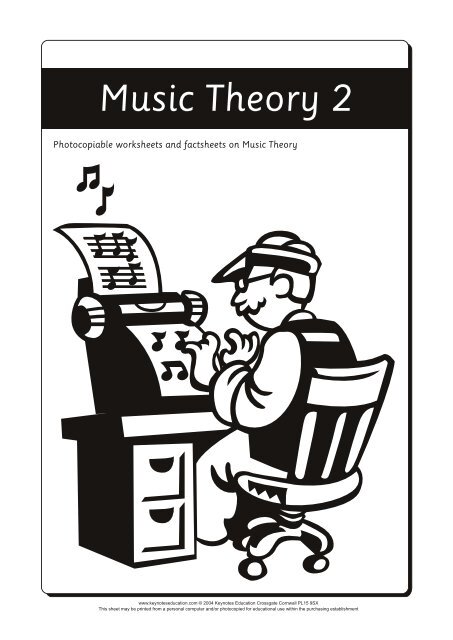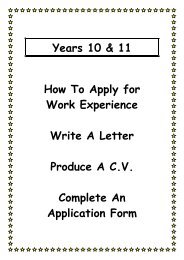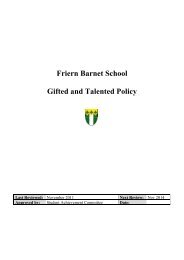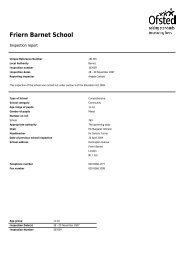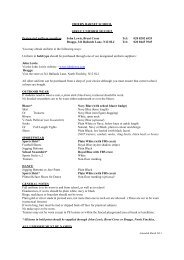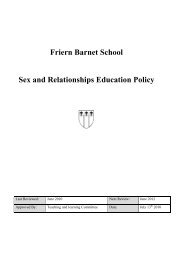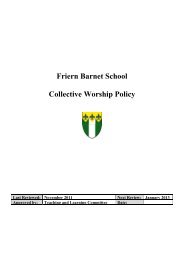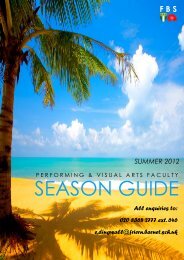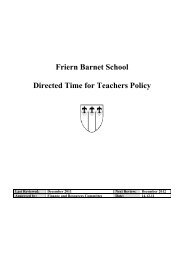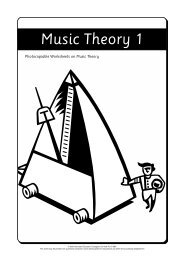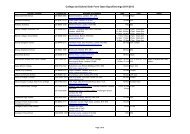VOL 166 Music Theory 2 - Friern Barnet School
VOL 166 Music Theory 2 - Friern Barnet School
VOL 166 Music Theory 2 - Friern Barnet School
Create successful ePaper yourself
Turn your PDF publications into a flip-book with our unique Google optimized e-Paper software.
<strong>Music</strong> <strong>Theory</strong> 2<br />
Photocopiable worksheets and factsheets on <strong>Music</strong> <strong>Theory</strong><br />
www.keynoteseducation.com © 2004 Keynotes Education Crossgate Cornwall PL15 9SX<br />
This sheet may be printed from a personal computer and/or photocopied for educational use within the purchasing establishment
Name: ____________________ <strong>Music</strong> <strong>Theory</strong> 2 Worksheet<br />
ALTO CLEF<br />
A clef fixes the pitch of notes on the stave. The alto clef is centred around the middle or 3rd<br />
line of the stave. This middle line tells the performer where the note middle C is found in this<br />
clef. Another name for the alto clef is the C clef.<br />
aaa C<br />
Originally the alto clef was used for<br />
the alto voice but is now commonly<br />
used for the viola.<br />
As you can see the range of the viola<br />
extends from the C below middle C<br />
right up to the C two octaves above<br />
middle C. This makes the alto clef<br />
convenient to use as the most usual<br />
notes played falls in the middle of<br />
this range.<br />
middle C<br />
The main reason for using the alto clef is that<br />
it helps to avoid too many leger lines when<br />
writing music for instruments that frequently<br />
use the lower notes in treble clef and the<br />
higher notes in bass clef.<br />
Viola range<br />
Practise<br />
2yuiop[]\as<br />
drawing the alto clef on aaaaaa<br />
the empty stave.<br />
2o[\ayisup]<br />
F G A B C D E F G A<br />
Write down the names of the notes below.<br />
`444444444444444<br />
Now rewrite these notes in treble clef at pitch. Watch out for the leger lines!<br />
www.keynoteseducation.com © 2004 Keynotes Education Crossgate Cornwall PL15 9SX<br />
This sheet may be printed from a personal computer and/or photocopied for educational use within the purchasing establishment<br />
w<br />
aaaaaa<br />
C :A<br />
w<br />
1
Name: ____________________ <strong>Music</strong> <strong>Theory</strong> 2 Worksheet<br />
346<br />
TENOR CLEF<br />
The tenor clef is centred around the 4th line of the stave. This 4th line tells the performer<br />
where the note middle C is found in this clef. Another name for the tenor clef is the C clef.<br />
middle C<br />
The most common instruments that<br />
use the tenor clef are the cello,<br />
bassoon and trombone.<br />
As with alto clef, using the tenor clef helps to avoid<br />
having to use too many leger lines. This would<br />
happen when writing for instruments that have a<br />
range from the bass clef up to the lower end of<br />
the treble clef and so the tenor clef is used instead.<br />
1w444w<br />
:A<br />
Cello range<br />
You can see from the diagram that<br />
the range of the cello extends from<br />
the C two octaves below middle C<br />
right up to top G in the treble stave.<br />
This makes the tenor clef convenient<br />
to use as the most usual notes played<br />
falls in the middle of this range.<br />
3yuiop[]4as<br />
w<br />
3pyi[\uoa]s<br />
D E F G A B C D E F<br />
Write down the names of the notes below.<br />
44444<br />
Practise drawing the tenor clef on<br />
the empty stave.<br />
`444444444444444<br />
Now rewrite these notes in treble clef at pitch. Watch out for the leger lines!<br />
www.keynoteseducation.com © 2004 Keynotes Education Crossgate Cornwall PL15 9SX<br />
This sheet may be printed from a personal computer and/or photocopied for educational use within the purchasing establishment<br />
2
Name: ____________________ <strong>Music</strong> <strong>Theory</strong> 2 Worksheet<br />
TRANSPOSITION<br />
Transposition in music simply means changing the pitch of a piece of music without altering the<br />
relation of one note to another. If you look at the extracts below you will see that although the<br />
first one is in C major the intervals have stayed the same when it has been transposed up a<br />
tone into D major. The major thirds in the accompaniment are still major thirds in the transposed<br />
extract. The minor third in the melody line is still a minor third in the transposed extract.<br />
major 3rd<br />
minor 3rd<br />
minor 3rd<br />
If you need to transpose a piece of music the most important thing to remember is that you<br />
must keep all the intervals the same as the original. It is particularly easy to forget to add a<br />
necessary accidental. If the key signature hadn’t been transposed in the extract above it might<br />
have been easy to forget the F and C sharps.<br />
On the empty stave below transpose the melody line of the C major extract down a tone.<br />
Try this with the key signature written in and then without using accidentals.<br />
On a separate piece of manuscript paper try writing out both parts a tone lower.<br />
The new key is:<br />
444444444444444444<br />
444444444444444444<br />
www.keynoteseducation.com © 2004 Keynotes Education Crossgate Cornwall PL15 9SX<br />
This sheet may be printed from a personal computer and/or photocopied for educational use within the purchasing establishment<br />
3
Name: ____________________ <strong>Music</strong> <strong>Theory</strong> 2 Worksheet<br />
MODES<br />
The origins of the major and minor scales we know today can be traced back to the Greeks.<br />
They are called Ionian and Aeolian. The Greeks also had several other different scales apart<br />
from those now comonly used in Western music. They named these scales after different tribes<br />
and the principal scales were Dorian, Phrygian, Lydian and Mixolydian. These scales all had<br />
individual characteristics of whole tones and semitones. These tones and semitones were fixed<br />
in descending order and each had a related scale which started a fifth below the main scale.<br />
These scales were given the prefix hypo which means under.<br />
`\][poiuy<br />
Dorian Hypodorian<br />
`[poiuytr<br />
Lydian Hypolydian<br />
`][poiuyt<br />
Phrygian Hypophrygian<br />
`poiuytre<br />
Mixolydian Hypomixolydian<br />
Early Christian musicians took these Greek scales and called them modes. The word mode<br />
actually means manner. These musicians ran the scales in ascending order starting on D, E, F<br />
and G. This changed the notes used dramatically. Compare the Greek scales above with the<br />
modes below.<br />
`tyuiop[]<br />
Dorian<br />
`uiop[]\a<br />
Lydian<br />
`yuiop[]\<br />
Phrygian<br />
`iop[]\as<br />
Mixolydian<br />
Write the correct modes below.<br />
`44444444<br />
Phrygian<br />
`44444444<br />
Dorian<br />
`44444444<br />
Mixolydian<br />
`44444444<br />
Lydian<br />
www.keynoteseducation.com © 2004 Keynotes Education Crossgate Cornwall PL15 9SX<br />
This sheet may be printed from a personal computer and/or photocopied for educational use within the purchasing establishment<br />
4
Name: ____________________ <strong>Music</strong> <strong>Theory</strong> 2 Worksheet<br />
DEMISEMIQUAVERS<br />
As you already know in music there are particular note shapes used to represent different time<br />
values. Demisemiquavers are very quick notes. If you look at the note pyramid below you can<br />
clearly see their value in relation to a semibreve.<br />
w<br />
h<br />
h<br />
K K K K<br />
LLLLLLLL<br />
MMMMMMMMMMMMMMMM<br />
NNNNNNNNNNNNNNNNNNNNNNNNNNNNNNNN<br />
1 semibreve<br />
2 minims<br />
4 crotchets<br />
8 quavers<br />
16 semiquavers<br />
32 demisemiquavers<br />
These very quick notes aren’t so common in music but usually occur as a result of double dots<br />
which can reduce the beat to smaller divisions. An even quicker note called a hemidemisemiquaver<br />
exists and there are 64 hemidemisemiquavers to one semibreve!<br />
A demisemiquaver rest looks like a semiquaver rest with an extra tail.<br />
Answer these questions true or false.<br />
One minim is worth 16 semiquavers<br />
Two quavers are equal to 8 demisemiquavers<br />
There are 32 semiquavers in one semibreve<br />
There are 24 demisemiquavers in a dotted minim<br />
One crotchet is equal to two quavers or eight demisemiquavers<br />
Now see if you can work out the answers to the questions below.<br />
K K K K + K K + L = crotchets<br />
K K K K K K K K + K K K K K K K K + K + K = minims<br />
www.keynoteseducation.com © 2004 Keynotes Education Crossgate Cornwall PL15 9SX<br />
This sheet may be printed from a personal computer and/or photocopied for educational use within the purchasing establishment<br />
Y<br />
5
Name: ____________________ <strong>Music</strong> <strong>Theory</strong> 2 Worksheet<br />
THE BREVE<br />
A breve is worth twice as much as a semibreve. This means that it is equal to eight crotchets.<br />
It is most commonly found in early music or some hymns which use the time signature of .<br />
Strangely, the word breve comes from the medieval period, where it actually meant a short note.<br />
Over the centuries this has changed to mean the opposite.<br />
A breve looks similar to a semibreve but has a line either<br />
side of the note. Sometimes it is also drawn with two<br />
lines on each side.<br />
The breve rest is written between the third and fourth<br />
lines of the stave and is a small rectangle which sits<br />
on the third line. A breve rest is used to indicate a 4<br />
whole bars rest in the time signature of 2.<br />
For every<br />
other time signature a whole bars rest is indicated by<br />
a semibreve rest.<br />
Fill in the chart below.<br />
breve<br />
breve rest<br />
544<br />
semibreve<br />
semibreve<br />
rest<br />
minim<br />
minim<br />
rest<br />
crotchet<br />
crotchet<br />
rest<br />
quaver<br />
quaver<br />
rest<br />
The breve<br />
www.keynoteseducation.com © 2004 Keynotes Education Crossgate Cornwall PL15 9SX<br />
This sheet may be printed from a personal computer and/or photocopied for educational use within the purchasing establishment<br />
or<br />
444544<br />
The breve rest<br />
semiquaver<br />
semiquaver<br />
rest<br />
4<br />
2<br />
A German Chorale melody using a breve.<br />
demisemiquaver<br />
J K<br />
N<br />
6<br />
demisemiquaver<br />
rest<br />
544 544 544 544 544 544<br />
W
Name: ____________________ <strong>Music</strong> <strong>Theory</strong> 2 Worksheet<br />
BEAMING<br />
Beaming is simply the musical term for grouping notes together. The clearest way to beam notes<br />
together is to think of what will be the easiest to read when playing the music. The clearest<br />
34<br />
division is usually by the main beat. In a simple time signature like this might mean grouping<br />
98<br />
notes into crotchet beats. In a compound time signature such as this might mean grouping<br />
notes into dotted crotchets.<br />
Compare the two short extracts below. In the first all the notes are written separately. Whilst<br />
you can read the music of the first extract it is not so easy to see where the beat is. In the<br />
second you can see that the groupings make it much easier to read and count.<br />
` 4<br />
aaaaaaaaaaaaaa<br />
A4 L L L L M ML L L K Q Q R R R R K<br />
(<br />
When writing music remember that with notes below the middle line, the note tails are on the<br />
right pointing upwards, and that notes above the middle line have tails on the left pointing<br />
downwards. The middle line itself can have tails going either way. It is usually best to put the<br />
tail of the notes on the middle line going the same way as the majority of notes in that bar.<br />
Equally, if you have one note in a group which crosses over the middle line beam it with the<br />
majority of the other notes in its group. Avoid using tied notes unless you really need to. They<br />
are usually used when a note is sustained from one bar to the next.<br />
`<br />
aaaaaaaaaaaaaa<br />
A LL<br />
6<br />
8 LL M L Q Q R<br />
. Q Q. Q L L LK .<br />
Rewrite the extract below with the correct beaming.<br />
(<br />
`<br />
aaaaaaaaaaaaaa<br />
A8 6<br />
www.keynoteseducation.com © 2004 Keynotes Education Crossgate Cornwall PL15 9SX<br />
This sheet may be printed from a personal computer and/or photocopied for educational use within the purchasing establishment<br />
7
Name: ____________________ <strong>Music</strong> <strong>Theory</strong> 2 Worksheet<br />
DOUBLE DOTS<br />
A dot after a note means that it is held for the original value plus half as much again.<br />
w<br />
A semibreve = 4 crotchets<br />
w. w h<br />
therefore a dotted semibreve = + = 6 crotchets<br />
4 + 2<br />
A double dot means that you add half the value plus half the value again.<br />
w.. w h q<br />
Therefore a double dotted semibreve = + + = 7 crotchets<br />
See if you can work out the value of these notes. Circle the correct answer.<br />
q..<br />
A double dotted crotchet = 7 semiquavers 5 semiquavers 9 semiquavers<br />
h..<br />
A double dotted minim = 4 quavers 7 quavers 8 quavers<br />
Write down the answers in the spaces provided.<br />
e..<br />
A double dotted quaver = demisemiquavers<br />
w..<br />
4 + 2 + 1<br />
A double dotted semibreve = quavers<br />
Add in the double dots where needed to makes these bars complete.<br />
www.keynoteseducation.com © 2004 Keynotes Education Crossgate Cornwall PL15 9SX<br />
This sheet may be printed from a personal computer and/or photocopied for educational use within the purchasing establishment<br />
8
Name: ____________________ <strong>Music</strong> <strong>Theory</strong> 2 Worksheet<br />
MUSICAL TERMS FACTSHEET<br />
This quick reference page contains a selection of some of the most common musical terms and<br />
symbols along with their meanings.<br />
largo<br />
larghetto<br />
lento<br />
adagio<br />
andante<br />
andantino<br />
moderato<br />
allegretto<br />
allegro<br />
presto<br />
prestissimo<br />
TEMPO<br />
slow and stately<br />
slightly quicker than largo<br />
very slow<br />
slow<br />
walking speed<br />
quick walking speed<br />
moderate speed<br />
quite fast<br />
fast and lively<br />
fast<br />
very fast<br />
CHANGING TEMPO<br />
accelerando<br />
ritardando<br />
rallentando<br />
(rall.)<br />
allargando<br />
ritenuto (rit.)<br />
piu mosso<br />
meno mosso<br />
a tempo<br />
tempo primo<br />
get faster<br />
gradually slow<br />
down<br />
gradually slow<br />
down<br />
broader<br />
slow down<br />
more movement<br />
less movement<br />
return to the<br />
previous speed<br />
return to the<br />
original speed<br />
molto pianissimo<br />
pianissimo<br />
piano<br />
mezzo piano<br />
mezzo forte<br />
forte<br />
fortissimo<br />
molto fortissimo<br />
crescendo<br />
diminuendo<br />
rf or rfz<br />
(rinforzando)<br />
fz (forzando)<br />
sf or sfz<br />
(loudly accented)<br />
D.C. (da capo)<br />
D.S. (dal segno)<br />
ten. (tenuto)<br />
OTHER TERMS<br />
DYNAMICS<br />
ppp<br />
<<br />
extremely quiet<br />
very quiet<br />
quiet<br />
quite quiet<br />
moderately loud<br />
loud<br />
very loud<br />
extremely loud<br />
gradually get louder<br />
gradually get quieter<br />
www.keynoteseducation.com © 2004 Keynotes Education Crossgate Cornwall PL15 9SX<br />
This sheet may be printed from a personal computer and/or photocopied for educational use within the purchasing establishment<br />
pp<br />
p<br />
mp<br />
mf<br />
f<br />
ff<br />
fff<br />
<<br />
heavily accented<br />
with force<br />
loudly accented<br />
go back to the<br />
beginning<br />
go back to the<br />
sign<br />
b<br />
hold the note<br />
9
Name: ____________________ <strong>Music</strong> <strong>Theory</strong> 2 Worksheet<br />
METRONOME MARKINGS & TEMPO INDICATIONS<br />
The metronome was invented by a man named Maelzel who lived from 1772-1838. It was<br />
designed to ensure that strict time was kept when playing a piece of music. Early metronomes<br />
were wound up and then ticked like a clock at a steady beat set by moving a sliding bar up and<br />
down. When you see a metronome marking it is usually written like this: M.M. q = 60.<br />
This<br />
means that there are 60 crotchet beats in one minute. This would be equal to one crotchet<br />
every second. The M.M. stands for Maelzel’s Metronome.<br />
Today metronomes come in all shapes and sizes but the basic principal is the same. Using a<br />
metronome when practising can be a useful method of making sure that you keep accurate<br />
time. Equally, if you are composing, adding a metronome marking can help to ensure that the<br />
music is performed at the correct speed, as it is more precise than simply writing adagio,<br />
andante, allegro etc.<br />
The beat indicated by a metronome does not have to be a crotchet. Sometimes you may wish<br />
to indicate the beat of minims or quavers. These would follow exactly the same format but the<br />
crotchet would be replaced by the note value you want to use. Below are two examples.<br />
M.M. e = 44 M.M. h = 56<br />
44 quavers in one minute 56 minims in one minute<br />
The number of beats per minute roughly correspond to the different musical terms as shown<br />
in the table.<br />
Work out the musical term that corresponds<br />
largo<br />
q = 40 - 60 to each tempo indication.<br />
larghetto<br />
lento<br />
adagio<br />
andante<br />
andantino<br />
moderato<br />
allegretto<br />
allegro<br />
presto<br />
prestissimo<br />
q<br />
q<br />
q<br />
q<br />
q<br />
q<br />
q<br />
q<br />
q<br />
q<br />
= 60 - 66<br />
= 66 -70<br />
= 70 - 76<br />
= 76 - 90<br />
= 90 - 108<br />
=108 - 116<br />
= 116 - 125<br />
= 125 - 168<br />
= 168 - 200<br />
= 200 - 208<br />
M.M. q = 64<br />
M.M. q = 120<br />
M.M. q = 144<br />
M.M. q = 86<br />
M.M. q = 132<br />
M.M. q = 100<br />
www.keynoteseducation.com © 2004 Keynotes Education Crossgate Cornwall PL15 9SX<br />
This sheet may be printed from a personal computer and/or photocopied for educational use within the purchasing establishment<br />
10
Name: ____________________ <strong>Music</strong> <strong>Theory</strong> 2 Worksheet<br />
IRREGULAR TIME SIGNATURES<br />
A time signature fixes the number of beats found in each bar. We are used to time signatures<br />
using duple, triple or quadruple time. The time signature helps us to see where the strong and<br />
weak beats fall in the bar. In irregular time signatures the number of beats in a bar are usually<br />
in groups of five or seven (quintuple or septuple). It is perhaps easiest to think of them as a<br />
combination of duple and triple time. For example 3 + 2 = 5, 3 + 4 = 7, or 2 + 3 + 2 = 7. The<br />
notes are grouped to reflect these combinations. In theory you can choose any number of beats<br />
in the bar. However, in practise composers tend to use five, seven or occasionally eleven.<br />
More than this becomes very difficult to read.<br />
Irregular time signatures are very common in eastern European and Asian music. Composers<br />
such as Stravinsky and Bartók frequently used irregular time signatures in their music. Bartók<br />
in particular was strongly influenced by Hungarian folk music and often used folk tunes and<br />
rhythms in his compositions.<br />
The English carol This is the truth sent from above is written in time. Try singing it to<br />
yourself and see how the words and music naturally fall into a pattern of 2 + 3.<br />
Occasionally you might see a dotted bar line dividing part of a bar in an irregular time signature.<br />
This is to clarify where the composer wishes the accents to fall.<br />
Answer the questions below.<br />
5<br />
4 means crotchets in a bar<br />
5<br />
2 means minims in a bar<br />
Now try to identify the time signature in this extract.<br />
www.keynoteseducation.com © 2004 Keynotes Education Crossgate Cornwall PL15 9SX<br />
This sheet may be printed from a personal computer and/or photocopied for educational use within the purchasing establishment<br />
5<br />
4<br />
7<br />
4 means crotchets in a bar<br />
7<br />
2 means minims in a bar<br />
11<br />
etc.
Name: ____________________ <strong>Music</strong> <strong>Theory</strong> 2 Worksheet<br />
DUPLETS<br />
A duplet, like a triplet, is an irregular note group. A triplet is three notes played in the time it<br />
would usually take you to play two. It is found in music written in simple time where the beats<br />
can be divided by two. A duplet is the opposite, two notes played in the time it would usually<br />
take you to play three. It is found in compound time signatures.<br />
This is easiest to understand by looking at the two extracts below.<br />
6<br />
8<br />
consists of two dotted crotchets. The duplet<br />
has two quavers played in the time it would<br />
normally take you to play three quavers<br />
www.keynoteseducation.com © 2004 Keynotes Education Crossgate Cornwall PL15 9SX<br />
This sheet may be printed from a personal computer and/or photocopied for educational use within the purchasing establishment<br />
3<br />
4<br />
12<br />
consists of three crotchet beats. The triplet<br />
has three quavers played in the time it would<br />
usually take you to play two.<br />
If you are playing a triplet or duplet divide them equally in proportion to the main beat. Using<br />
a slur or a square bracket above the notes that are part of the duplet or triplet make it easier<br />
to read.<br />
Study the extracts below and add in the duplet or triplet signs where needed to make the<br />
bars add up correctly.<br />
No try and compose two four bar phrases one in simple time using a triplet figure and<br />
one<br />
`44444444444444444<br />
in compound time using a duplet figure.<br />
`44444444444444444
Name: ____________________ <strong>Music</strong> <strong>Theory</strong> 2 Worksheet<br />
D<br />
DOUBLE SHARPS<br />
Adding a sharp to a note raises it one semitone.<br />
H<br />
A double sharp raises a note two semitones which is equal to one whole tone. A double sharp<br />
looks rather like a cross .<br />
If you look at the piano keyboard below you can see that G is one whole tone higher than<br />
the note G and actually sounds the note A.<br />
G double sharp (sounds A natural)<br />
If you want to cancel a double sharp use a single sharp sign D . Although some composers use<br />
a natural sign followed by a single sharp like this FD . Double sharps are usually only found in<br />
keys that already have several sharps.<br />
Try drawing in a double sharp before each of these notes. Make sure it is in the space or<br />
on<br />
`55i55t55p55e55o55]55y<br />
the line that you want to apply it to!<br />
In the scale of G sharp harmonic minor the leading note becomes F double sharp. This is because<br />
F sharp is already found in the key signature and so to raise this seventh note half a step higher<br />
requires the double sharp.<br />
`44i5o5p5[5]5\5a5s5<br />
D D H<br />
D DD<br />
Rewrite<br />
`66666666666666666666666666666666666666666666666666666666<br />
this scale out using accidentals and not the key signature.<br />
www.keynoteseducation.com © 2004 Keynotes Education Crossgate Cornwall PL15 9SX<br />
This sheet may be printed from a personal computer and/or photocopied for educational use within the purchasing establishment<br />
H<br />
G natural<br />
13
Name: ____________________ <strong>Music</strong> <strong>Theory</strong> 2 Worksheet<br />
DOUBLE FLATS<br />
Adding a flat to a note lowers it one semitone.<br />
A double flat lowers a note two semitones which is equal to one whole tone. A double flat<br />
looks like two flats joined together .<br />
If you look at the piano keyboard below you can see that B is one whole tone lower than<br />
the note B and actually sounds the note A.<br />
If you want to cancel a double flat use a flat sign . Some composers use a natural sign followed<br />
by a single flat like this . Double flats are usually only found in keys that already have several<br />
flats.<br />
E<br />
FE<br />
G<br />
Try drawing in a double flat before each of these notes. Make sure it is in the space or<br />
on<br />
`55i55t55p55e55o55]55y<br />
the line that you want to apply it to!<br />
Answer these questions.<br />
B double flat sounds the note<br />
F double flat sounds the note<br />
D double flat sounds the note<br />
A double flat sounds the note<br />
E<br />
www.keynoteseducation.com © 2004 Keynotes Education Crossgate Cornwall PL15 9SX<br />
This sheet may be printed from a personal computer and/or photocopied for educational use within the purchasing establishment<br />
G<br />
B double flat (sounds the note A)<br />
B natural<br />
C double flat sounds the note<br />
G double flat sounds the note<br />
E double flat sounds the note<br />
14
Name: ____________________ <strong>Music</strong> <strong>Theory</strong> 2 Worksheet<br />
AUGMENTED AND DIMINISHED INTERVALS<br />
An augmented interval occurs when a perfect or major interval is made a semitone bigger. A<br />
diminshed interval occurs when a perfect or minor interval is made a semitone smaller. The<br />
chart below shows all the intervals available up to an octave starting on the note C.<br />
Perfect<br />
Intervals<br />
Major<br />
Intervals<br />
Minor<br />
Intervals<br />
Augmented<br />
Intervals<br />
Diminished<br />
Intervals<br />
`5rr5<br />
Try to recognise the intervals below.<br />
Use the keyboard to help you. It may help<br />
to work out the number of semitones in<br />
each interval and always include the notes<br />
you start and finish on!<br />
`5 55 w<br />
`5 55 w<br />
`5r 5 `5 55<br />
w<br />
w<br />
`5r 5 E w<br />
`5r 5 Dw<br />
`5r 5 E w<br />
`5 55 Ew<br />
`5 55 D w<br />
`5 55 Ew<br />
w<br />
`5 55 w<br />
`5 55 w<br />
`5 55 E w<br />
`5 55 D w<br />
`5 55 G w<br />
`5 55 w<br />
w<br />
`5 55 w<br />
w<br />
`5 55 E w<br />
w<br />
`5 55 D w<br />
`5 55 G w<br />
w<br />
G A B C D E F G A B C D E<br />
`5 55 `5r 5 `5 55 `5 55<br />
w<br />
w w<br />
w D w<br />
w D w<br />
`5 55 `5 55<br />
D w<br />
w E ` 5 `5 55 `5 55<br />
w w<br />
w<br />
www.keynoteseducation.com © 2004 Keynotes Education Crossgate Cornwall PL15 9SX<br />
This sheet may be printed from a personal computer and/or photocopied for educational use within the purchasing establishment<br />
15
Name: ____________________ <strong>Music</strong> <strong>Theory</strong> 2 Worksheet<br />
CHROMATIC SCALES<br />
If you start on the note C and play all the notes from C up to the C an octave above you get<br />
a pattern of twelve semitones, this is called a chromatic scale. A chromatic scale can go up<br />
or down and start on any note. Usually when writing a chromatic scale the notes are sharpened<br />
on the way up and flattened on the way down. The word chromatic actually means coloured<br />
and the scale is often used to add colour in a piece or to demonstrate a performer’s technique.<br />
It was particularly popular during the Romantic period.<br />
`rrttyuuiioop[ppooiiuyyttr<br />
D D D D D E E E E E<br />
`t44444444444444<br />
Write an ascending chromatic scale starting on D.<br />
`a44444444444444<br />
Write a descending chromatic scale starting on F.<br />
`444444444444444<br />
Write an ascending chromatic scale starting on G.<br />
`444444444444444<br />
Write a descending chromatic scale starting on E.<br />
www.keynoteseducation.com © 2004 Keynotes Education Crossgate Cornwall PL15 9SX<br />
This sheet may be printed from a personal computer and/or photocopied for educational use within the purchasing establishment<br />
16
Name: ____________________ <strong>Music</strong> <strong>Theory</strong> 2 Worksheet<br />
CHORD INVERSION<br />
A chord is a group of three or more notes played together. Three notes played together form<br />
what is known as a triad. There is a triad for every note in every scale. These triads are made<br />
up from the starting note plus the note a third above, plus the note a fifth above the starting<br />
note. Below you can see the triads formed in the key of C major.<br />
` 5444444444444444445<br />
w w w w w w w w<br />
1 11 111 1V V V1 V11 I<br />
When you play a piece of music the notes of the triad are not always arranged in the same order.<br />
This is called inversion. If you look at chord I in C major there are three main positions for the<br />
notes. These three positions are called root position, first inversion and second inversion. If you<br />
are using Roman numerals these positions become a, b and c. The important note when working<br />
out the inversion is the bottom note as this tells you which inversion the chord is in. Check<br />
whether<br />
` 544444445<br />
it starts on note 1, 3 or 5 of the chord.<br />
w w<br />
w w<br />
5<br />
3<br />
1<br />
w w w w ` 544444445<br />
root<br />
position<br />
on C (1)<br />
first<br />
inversion<br />
on E (3)<br />
second<br />
inversion<br />
on G (5)<br />
Chord 1a 1b 1c<br />
in C major<br />
Sometimes when writing a chord in root position the a is dropped as everyone knows it is a<br />
root position chord. In the chord above it would be equally correct just to write 1 rather than<br />
1a.<br />
Try to work out these chord positions. Write them down in Roman numerals. The first<br />
one is done for you. They are all in the key of C major.<br />
` 545 w<br />
` 545 ` 545 ` 545<br />
w<br />
w<br />
w<br />
11b<br />
` 545 ` 545 ` 545 ` 545<br />
w<br />
w<br />
w<br />
w<br />
w<br />
w<br />
www.keynoteseducation.com © 2004 Keynotes Education Crossgate Cornwall PL15 9SX<br />
This sheet may be printed from a personal computer and/or photocopied for educational use within the purchasing establishment<br />
17
Name: ____________________ <strong>Music</strong> <strong>Theory</strong> 2 Worksheet<br />
SEVENTH CHORDS - DOMINANT SEVENTH<br />
Many common chords are simply made up from triads which use the root note plus the third<br />
note, plus the fifth note. To make chords a little more interesting or unusual sometimes composers<br />
add in the seventh note. The most common seventh chord is the dominant seventh. This sounds<br />
horribly complicated but is really quite straightforward. The fifth note of the scale is called the<br />
dominant. If you are in C major the dominant would sound the note G. The dominant seventh<br />
in C major is a chord built on this G. The dominant seventh starts off the same as any triad using<br />
the starting note plus the third note, plus the fifth note but then adds on the seventh note. This<br />
means you end up with the notes G, B, D and F.<br />
` 545 w<br />
w ` w545<br />
w<br />
dominant seventh<br />
chord in C major<br />
Just as we use Roman numerals<br />
for ordinary triads you can do<br />
the same for dominant sevenths.<br />
This chord in C major would be<br />
written like this: V 7<br />
In ordinary triads if we change the position of the chord indicate it by saying root position, first<br />
inversion or second inversion. If we are using Roman numerals we might say a, b or c. In a chord<br />
like a dominant seventh which has four different notes we simply add in third inversion and in<br />
` 545 w<br />
w ` 545 w w ` 545<br />
w<br />
` 545<br />
w<br />
w<br />
w ww<br />
Roman numerals the letter d.<br />
V 7 a V 7 b V 7 c V 7 d<br />
root<br />
position<br />
first<br />
inversion<br />
second<br />
inversion<br />
third<br />
inversion<br />
Write the four positions for the dominant seventh chord in G major and D major.<br />
The first one has been done for you.<br />
`5” 545 `5” 545 `5” 545 `5” 545<br />
w<br />
w<br />
V 7 a<br />
`5”5È 545 `5”5È 545 `5”5È 545 `5”5È 545<br />
www.keynoteseducation.com © 2004 Keynotes Education Crossgate Cornwall PL15 9SX<br />
This sheet may be printed from a personal computer and/or photocopied for educational use within the purchasing establishment<br />
18
Name: ____________________ <strong>Music</strong> <strong>Theory</strong> 2 Worksheet<br />
MODULATION<br />
If music always stayed in the key it started in it would be rather boring to listen to. Most pieces<br />
move to a new key at some point even though it will usually work its way back to the original<br />
key by the end of the piece. This is called modulation. The word modulation comes from the<br />
Latin verb to adjust.<br />
The easiest way to change key is by using a pivot chord. A pivot chord is one that is found in<br />
both the old key and the new key. The C major tonic chord based on the note C could also be<br />
seen as the dominant chord in F major, or the subdominant chord in G major. If you wanted<br />
to move to the key of G from C major you could treat the C major chord as the subdominant<br />
in the new key. Use this chord to then move to the dominant in the new key (a D major chord).<br />
From there you can move easily to the tonic chord of G.<br />
See how the note C relates to the different keys in the scales below.<br />
Tonic in C<br />
`rtyuiop[<br />
Subdominant in G<br />
`iop[]\”as<br />
Study the extract below and see how Bach changes the key from A major to E Major by using<br />
the dominant chord in A major (E major) as the tonic chord in the new key. By adding in the<br />
D sharps which are found in the new key, Bach fixes E major as the new tonic key. Introducing<br />
flats or sharps that are found in the new key are a great clue to modulation. Write them down<br />
in order to help you work out the new key.<br />
Work out what key this piece modulates to before returning to the original key.<br />
Key: Key: Key:<br />
www.keynoteseducation.com © 2004 Keynotes Education Crossgate Cornwall PL15 9SX<br />
This sheet may be printed from a personal computer and/or photocopied for educational use within the purchasing establishment<br />
Dominant in F<br />
19<br />
`uioŸp[]\a
Name: ____________________ <strong>Music</strong> <strong>Theory</strong> 2 Worksheet<br />
PASSING AND AUXILIARY NOTES<br />
A passing note as the name suggests doesn’t form a part of a chord it just passes between notes<br />
which are found in the harmony chords, linking them together. Passing notes are usually found<br />
on the weak beats of the bar and move by step. The passing note always falls between two notes<br />
moving in the same direction and can occur in any voice part.<br />
= passing note<br />
An accented passing note falls on the strong beat of the bar but unaccented passing notes<br />
which fall on the weak beat of the bar are more commonly used.<br />
unaccented<br />
passing note<br />
An auxiliary note is written<br />
between two notes of the same<br />
name. An upper auxiliary note<br />
moves one step higher than the<br />
original note and then returns to it<br />
and a lower auxiliary note moves<br />
one step lower than the original<br />
note and then returns to it. An<br />
auxiliary note can either move a<br />
tone or a semitone.<br />
accented<br />
passing note<br />
upper<br />
auxiliary notes<br />
lower<br />
auxiliary notes<br />
www.keynoteseducation.com © 2004 Keynotes Education Crossgate Cornwall PL15 9SX<br />
This sheet may be printed from a personal computer and/or photocopied for educational use within the purchasing establishment<br />
Bach<br />
Find the passing and auxiliary notes in the extract<br />
below. Write P for the passing notes and A for the<br />
auxiliary notes.<br />
20
Name: ____________________ <strong>Music</strong> <strong>Theory</strong> 2 Worksheet<br />
SIGNS FOR REPETITION<br />
Often in music you will find various signs for repeating sections of a piece. This means that<br />
rather than writing out every repeat and adding many pages to the score you simply follow the<br />
signs. There are various signs in music to show that the music needs to be repeated. These may<br />
be used to show a repeat of a whole piece, a section or even particular musical notes in a bar.<br />
These vary quite widely and some are easier to work out than others!<br />
If you want to repeat one section exactly then drawing a double bar line with two dots either<br />
side of the middle line is the easiest way. Place one where you are starting the repeat and the<br />
other in the bar where you want the repeat to stop. Usually this is at the beginning and end of<br />
the bar but it can be put anywhere in the bar. You will still need to add in the barline if it is<br />
midway through the bar to make the bar add up correctly. If you are repeating back to the<br />
beginning of a piece then you can leave out the first set of dots.<br />
55555555555<br />
{55555555555<br />
repeat between these two points<br />
If the music changes the second time through you will need to draw in a first and second time<br />
bar, so that the performer knows where the music goes to. This is shown in the example below.<br />
`5()vv5bWQ+F55_(5<br />
1<br />
2<br />
.<br />
}<br />
A first and second time bar can extend over one or more bars and you simply extend the line<br />
to show how many bars.<br />
Sometimes in music you see the words Da Capo or D.C. for short. This means from the<br />
beginning. The end of the music is then shown by the word Fine and/or a pause mark .<br />
b<br />
4 4<br />
Dal Segno or D. S. means from the sign. You return to the point in the music marked with the<br />
sign and then play to the word Fine or the pause mark g<br />
. If there is a coda you may see<br />
the phrase D b al coda which means you repeat back to either the beginning or the sign b<br />
until you see the different sign n which means that you then play the coda to finish the piece.<br />
www.keynoteseducation.com © 2004 Keynotes Education Crossgate Cornwall PL15 9SX<br />
This sheet may be printed from a personal computer and/or photocopied for educational use within the purchasing establishment<br />
g<br />
21<br />
{
Name: ____________________ <strong>Music</strong> <strong>Theory</strong> 2 Worksheet<br />
PERFECT AND IMPERFECT CADENCES<br />
The most important chords in any scale are the chords built on the tonic (1), subdominant (1V)<br />
and the dominant (V) notes. These chords are called primary triads. The ends of phrases frequently<br />
use these chords in various combinations and these are called cadences.<br />
A perfect cadence or full close uses the combination of the dominant chord (V) to the tonic<br />
chord (1). A perfect cadence is the musical equivalent of a full stop. When writing out chords<br />
you often need to double one of the notes to make a four part chord. This is based on the four<br />
voices soprano, alto, tenor and bass. To make the fourth note you need to double one of the<br />
notes, usually the root or fifth. It is best not to double the third note of the chord as this can<br />
sound weak.<br />
C major<br />
qQ<br />
h<br />
H<br />
15444444<br />
q h<br />
Q<br />
H<br />
V 1<br />
A minor<br />
15444444 D qQ<br />
h<br />
H<br />
V 1<br />
An imperfect cadence or half close is the chord progression from any chord to the dominant<br />
chord (V). The most common chords that precede it are chords II, IV, VI or I.<br />
1V V 1 V<br />
Try to identify the cadences below and write perfect or imperfect in each box.<br />
G major D major B Minor C Major<br />
D qQ<br />
C major<br />
15444444<br />
q h<br />
A minor<br />
Q H<br />
h<br />
H<br />
15444444<br />
q h<br />
Q<br />
H<br />
qQ<br />
qQ<br />
q<br />
hH<br />
15444444<br />
h<br />
Q H<br />
D hH<br />
D q h<br />
D Q D H<br />
www.keynoteseducation.com © 2004 Keynotes Education Crossgate Cornwall PL15 9SX<br />
This sheet may be printed from a personal computer and/or photocopied for educational use within the purchasing establishment<br />
q<br />
Q<br />
Q<br />
q<br />
15444444 D qQ<br />
h<br />
H<br />
D<br />
h<br />
H<br />
D<br />
hH<br />
15444444<br />
q h<br />
H<br />
Q<br />
qQ<br />
h<br />
H<br />
22<br />
15444444<br />
q h<br />
Q<br />
H
Name: ____________________ <strong>Music</strong> <strong>Theory</strong> 2 Worksheet<br />
PLAGAL AND INTERRUPTED CADENCES<br />
A plagal cadence is the move from the subdominant chord (1V) to the tonic chord (1).<br />
Sometimes people call the plagal cadence the Amen cadence because it is commonly used in<br />
church music. This makes it quite easy to recognise.<br />
q<br />
Q<br />
C major<br />
15444444<br />
A minor<br />
qQ<br />
h<br />
H<br />
h<br />
H<br />
15444444<br />
q h<br />
H<br />
Q<br />
1V 1 1V 1<br />
An interrupted cadence is the move from the dominant (V) to the submediant (V1). Again this<br />
chord is quite easy to recognise as this move has a surprise feel to it. It is the most obviously<br />
unfinished of any cadence.<br />
Try to identify the cadences below and write plagal or interrupted in each box.<br />
D qQ<br />
C major<br />
15444444<br />
A minor<br />
q<br />
Q Hh<br />
G major B flat major F sharp Minor D Major<br />
h<br />
H<br />
15444444<br />
q<br />
Q Hh<br />
qQ<br />
V V1 V V1<br />
E<br />
E<br />
q<br />
Q<br />
h<br />
H<br />
E h<br />
H<br />
15444444 E qQ<br />
E<br />
h<br />
H<br />
D q<br />
Q D hH<br />
www.keynoteseducation.com © 2004 Keynotes Education Crossgate Cornwall PL15 9SX<br />
This sheet may be printed from a personal computer and/or photocopied for educational use within the purchasing establishment<br />
qQ<br />
D<br />
qQ<br />
15444444<br />
q<br />
D<br />
h<br />
H<br />
Q<br />
D<br />
hH<br />
hH<br />
15444444<br />
q h<br />
Q H<br />
D qQ<br />
h<br />
D H<br />
23<br />
15444444<br />
q<br />
Q Hh
Name: ____________________ <strong>Music</strong> <strong>Theory</strong> 2 Worksheet<br />
PHRASING<br />
Phrasing is a vital element in any piece of music. Without phrasing the music can become one<br />
long rambling sentence with no punctuation! When composing you should try to think about<br />
the structure of your musical line whether rhythmic or melodic. As a performer too it is important<br />
to decide how you wish to phrase a piece as this will affect the way the music sounds to an<br />
audience.<br />
The end of a phrase is usually created by a cadence. Cadences act as a natural form of musical<br />
punctuation. When you are composing always consider the instruments that you are writing for<br />
so don’t write a vocal line with no thought to where the singer can take a breath! In some<br />
modern compositions you may want a deliberately unbalanced melodic line. However, generally<br />
speaking it is best to try to balance your musical phrases. Often musical sentences are composed<br />
in eight bar sections consisting of two groups of four.<br />
Look at the music example below from Beethoven’s 9th Symphony. Draw in where you<br />
think the phrase marks should be. These marks should be a curved line above the notes<br />
in each phrase.<br />
Notice how the melody and rhythm are almost identical. But by simply moving the last<br />
three notes down a tone Beethoven has created a perfect cadence which makes the<br />
second phrase sound complete. Now write your own eight bar melody below. Try to make<br />
it balance into two four bar phrases.<br />
å<br />
D<br />
å D<br />
q q q q q q q q q q q q q. e h<br />
D<br />
D<br />
q q q q q q q q q q q q q e h .<br />
www.keynoteseducation.com © 2004 Keynotes Education Crossgate Cornwall PL15 9SX<br />
This sheet may be printed from a personal computer and/or photocopied for educational use within the purchasing establishment<br />
24
Name: ____________________ <strong>Music</strong> <strong>Theory</strong> 2 Worksheet<br />
ARTICULATION<br />
There are several signs for showing how you wish notes to be grouped or phrased. These are<br />
called articulation marks.<br />
One of the most common articulation marks is<br />
the slur which looks likes a short phrase mark.<br />
The main difference between a slur and a phrase<br />
mark is that the phrase mark covers the whole<br />
phrase and a slur is usually used between two<br />
or three notes. A slur shows that the notes need<br />
to be played smoothly as a group. Don’t confuse<br />
it with a tie!<br />
A staccato sign is indicated by a dot either above<br />
or below a note. The word staccato means<br />
detached and indicates that the note must be<br />
shortened to create this effect. Obviously in a<br />
slower piece the note will not be as short as in<br />
a quicker one as there is more time to play the<br />
notes!<br />
If you want the note to be played very short,<br />
detached and accented then you would draw a<br />
wedge shaped dash above the note. This is called<br />
staccatissimo.<br />
The opposite of staccato is tenuto. The word<br />
tenuto comes from the verb to hold. This is<br />
sometimes written as ten. and is indicated by a<br />
short line. If something is marked tenuto then it<br />
needs to held for their full value and sometimes<br />
even a little longer.<br />
Identify the articulation marks in the extract below.<br />
Slur<br />
Staccato<br />
Staccatissimo<br />
Tenuto<br />
www.keynoteseducation.com © 2004 Keynotes Education Crossgate Cornwall PL15 9SX<br />
This sheet may be printed from a personal computer and/or photocopied for educational use within the purchasing establishment<br />
25
Name: ____________________ <strong>Music</strong> <strong>Theory</strong> 2 Worksheet<br />
SHORT SCORE<br />
Often when writing for soprano, alto, tenor and bass voices instead of using a separate stave for<br />
each part two staves are used. This is called short score. The soprano and alto lines are written<br />
in treble clef and the tenor and bass in bass clef. Using short score saves a lot of space on the<br />
page but does tend to mean that you need rather more leger lines!<br />
When writing in short score the main thing to remember is that the traditional approach to<br />
which way the tails of the notes go no longer applies. The soprano part is written with the<br />
tails pointing upwards and the alto with tails down. This is the same in the tenor and bass<br />
parts. The tenor part will have tails up and the bass part tails down.<br />
It is also important to realise and remember that if you write an accidental in a bar for one voice<br />
part it does not apply to any of the other parts. You will need to write them in for each part.<br />
Obviously if there is a key signature these accidentals would apply to all. Be careful when writing<br />
the tenor part as it will need to be written an octave higher than in open score.<br />
Bach<br />
Rewrite the extract below in short score on manuscript paper.<br />
Compare these same<br />
bars in open score and<br />
short score.<br />
www.keynoteseducation.com © 2004 Keynotes Education Crossgate Cornwall PL15 9SX<br />
This sheet may be printed from a personal computer and/or photocopied for educational use within the purchasing establishment<br />
Bach<br />
26
Name: ____________________ <strong>Music</strong> <strong>Theory</strong> 2 Worksheet<br />
OPEN SCORE<br />
In an open score each vocal line has an individual stave. The soprano and alto parts are written<br />
in the treble clef and the bass part is written in the bass clef. The awkward part is the tenor<br />
line. The tenor part is written in treble clef but an octave higher than it is actually sung. The sign<br />
to indicate this is a treble clef with a number eight attached to the bottom.<br />
The usual rules for the way that the tails are positioned up or down apply unlike in open score<br />
where the direction of the tail is dependent on the voice part. If you are writing parts out in<br />
open score group them together with a bracket and a line joining the staves together. This<br />
makes it clear where each line of music ends and the next begins. Usually the soprano, alto,<br />
tenor and bass parts are indicated by an S, A, T, B or Soprano, Alto, Tenor and Bass at the<br />
beginning of the first stave.<br />
Always try to line the parts up vertically in beats as far as possible so that the score is clear<br />
for both vocalist and conductor/accompanist.<br />
Byrd<br />
On a sheet of manuscript paper write this music out in open score.<br />
www.keynoteseducation.com © 2004 Keynotes Education Crossgate Cornwall PL15 9SX<br />
This sheet may be printed from a personal computer and/or photocopied for educational use within the purchasing establishment<br />
27
Name: ____________________ <strong>Music</strong> <strong>Theory</strong> 2 Worksheet<br />
WRITING FOR BRASS<br />
When writing for any instrument it is important to bear in mind the range of notes that can be<br />
played and that when writing at the very top or bottom of the range these notes can be quite<br />
difficult to produce. This might be fine for a professional musician but no good for a relative<br />
beginner!<br />
A complication in writing for Brass instruments is that the horn and trumpet are transposing<br />
instruments. This means that the note written is not the same pitch that the instrument sounds.<br />
<strong>Music</strong> for the F French horn is written in both treble and bass clef and is written a perfect fifth<br />
higher than it sounds.<br />
The trumpet is usually pitched in either C, B flat or A. If you are writing for a C trumpet you<br />
don’t need to transpose the notes. If writing for a B flat trumpet, which is the most common<br />
trumpet, then the notes are written a major second higher than they sound. If the trumpet<br />
sounds a B flat when playing the written note C the distance between what is written and what<br />
is heard is a major second so this is the interval of transposition.<br />
If writing for an A Trumpet you would write the music a minor third higher than it sounds because<br />
when the music says a C the instrument sounds the A a minor third below. If you don’t remember<br />
the transposition you will have major problems when the instrument comes to play with another<br />
instrument!<br />
Tuba pitch<br />
sounds as written<br />
B flat Trumpet pitch<br />
sounds a major second lower<br />
Trombone pitch<br />
sounds as written<br />
Horn in F pitch<br />
sounds a perfect fifth lower<br />
The tone on brass instruments can be altered by using<br />
a mute. The usual musical direction for indicating this<br />
is con sord. and senza cord. when you no longer<br />
want the mute to be used.<br />
Horn players sometimes insert their hand into the<br />
bell of the instrument to alter the sound and this is<br />
called stopping. It is indicated by a small + over the<br />
notes and then a to cancel it.<br />
o<br />
www.keynoteseducation.com © 2004 Keynotes Education Crossgate Cornwall PL15 9SX<br />
This sheet may be printed from a personal computer and/or photocopied for educational use within the purchasing establishment<br />
28
Name: ____________________ <strong>Music</strong> <strong>Theory</strong> 2 Worksheet<br />
WRITING FOR STRINGS (Part 1)<br />
As with any instrument the first consideration when writing for strings is to consider the pitch<br />
range of the instrument. It is also important to remember that in string writing a phrasing slur<br />
often shows the number of notes to be played in one bow rather than indicating the musical<br />
phrase shape.<br />
To indicate the direction of bowing use one<br />
of these two signs.<br />
downbow upbow<br />
When string players play a note without pressing their fingers on the fingerboard it is called an<br />
open string. Once the player presses down on the fingerboard this shortens the length of the<br />
string and it is said to be stopped.<br />
A different sound colour can be produced by playing a note on a different string. If you wanted<br />
to specify the string to be used this would be done by the phrase sul A, sul D etc.<br />
If two notes are played on the same string the<br />
performer would usually use two different<br />
fingers. If you wanted them to slide between<br />
the notes using the same finger you can draw<br />
a line between the two notes. This is called<br />
portamento.<br />
If you want the string player to pluck the string rather than bow it use the word pizzicato or<br />
pizz. To return to playing with the bow the word arco is used.<br />
If a player plays alternating bow strokes on single<br />
notes this is called a bowed tremolo. This is<br />
shown by three lines above or below the note<br />
for semibreves, three lines through the tail of<br />
the note if it is a minim or crotchet, two lines<br />
through the tail of the note for quavers and one<br />
line through the tail of the note for semiquavers.<br />
`6555555<br />
q q<br />
w h q etc.<br />
A double stop on a stringed instrument is when more than one note is palyed at the same time.<br />
Stringed instruments can only physically sustain two strings at once but you can play a three or<br />
four part chord by bowing quickly across the strings.<br />
www.keynoteseducation.com © 2004 Keynotes Education Crossgate Cornwall PL15 9SX<br />
This sheet may be printed from a personal computer and/or photocopied for educational use within the purchasing establishment<br />
29
Name: ____________________ <strong>Music</strong> <strong>Theory</strong> 2 Worksheet<br />
WRITING FOR STRINGS (Part 2)<br />
By lightly playing the string at set points along the string a series of natural harmonics can be<br />
produced. The set points where these faint secondary sounds vibrate in addition to the main<br />
note are called nodes. If these are played on an open string it is called a natural harmonic. If<br />
you firmly press down the string, this is called stopping, and then play at one of the set points<br />
it is called an artificial harmonic. These are indicated by the signs below. Harmonics are not<br />
loud clear notes but they produce more of a colour to the note.<br />
q o<br />
As with any instrument the first consideration when writing for strings is to consider the pitch<br />
range of the instrument.<br />
Violin pitch<br />
Cello pitch<br />
O<br />
q<br />
natural harmonic artificial harmonic<br />
Viola pitch<br />
usually written in alto clef<br />
Double bass pitch<br />
the double bass<br />
sounds an octave lower<br />
than written<br />
Col legno (Italian meaning with wood). Use the wood of the bow to play.<br />
Sul ponticello (Italian meaning on the bridge). Bow as near to the bridge as possible. This<br />
makes a scratchy, creepy effect.<br />
Sul tasto (Italian meaning on the fingerboard). Bow over the fingerboard. This creates a very<br />
mellow sound.<br />
www.keynoteseducation.com © 2004 Keynotes Education Crossgate Cornwall PL15 9SX<br />
This sheet may be printed from a personal computer and/or photocopied for educational use within the purchasing establishment<br />
30
Name: ____________________ <strong>Music</strong> <strong>Theory</strong> 2 Worksheet<br />
WRITING FOR WOODWIND<br />
The cor anglais, clarinet and saxophone are transposing instruments. The cor anglais sounds<br />
a fifth lower than it is written which is relatively straightforward. However, there are several<br />
different pitches of clarinet available. The C clarinet is commonly used to introduce young<br />
people to the instrument and does not transpose. The B flat clarinet like the B flat trumpet<br />
sounds a major second lower than written and the A clarinet sounds a minor third lower<br />
than written.<br />
The saxophone comes in four sizes. The B flat soprano sounds a major second lower than<br />
written, the E flat alto sounds a major sixth lower than written, the B flat tenor sounds a<br />
an octave plus a tone lower than written and the E flat baritone sounds a full octave plus<br />
a major sixth lower than written.<br />
If you are writing for the piccolo remember that it sounds an octave higher than written. This<br />
helps to avoid too many leger lines.<br />
Flute pitch<br />
Oboe pitch<br />
Clarinet in B flat pitch<br />
as it sounds<br />
The range for the piccolo is nearly the same as the flute<br />
but sounds one octave higher. The lowest note on the<br />
piccolo is a D rather than a C as on the flute.<br />
The actual written range of the saxophone is the same<br />
for all four sizes although the actual note produced<br />
varies depending on the instrument size.<br />
Cor anglais pitch<br />
as it sounds<br />
Clarinet in A pitch<br />
as it sounds<br />
Saxophone pitch<br />
as written<br />
Bassoon pitch<br />
www.keynoteseducation.com © 2004 Keynotes Education Crossgate Cornwall PL15 9SX<br />
This sheet may be printed from a personal computer and/or photocopied for educational use within the purchasing establishment<br />
(<br />
)<br />
31
Name: ____________________ <strong>Music</strong> <strong>Theory</strong> 2 Worksheet<br />
WRITING FOR PERCUSSION<br />
The percussion section of the orchestra is one of the most varied with a vast range of instruments<br />
to choose from. Percussion instruments fall into two categories tuned and untuned. Tuned<br />
percussion instruments are capable of producing a pitched note whilst untuned percussion<br />
instruments produce an effect rather than an identifiable pitch.<br />
The main percussion instrument found in the orchestra is the timpani or kettle drums. These<br />
are usually played in groups of two or three and each drum has a range of around a fifth. The<br />
tuning for timpani is usually stated at the beginning of a piece of music and you can use a key<br />
signature if you wish. If you need the drums to change pitch during a piece then the Italian phrase<br />
muta, meaning for change, is written followed by the note it is changing from and the new note<br />
required (e.g. muta A in B ).<br />
Timpani parts are written in bass clef. If you want to show a drum roll then it is written rather<br />
like an extended trill above the note you want it to affect.<br />
1555p55555p555<br />
xmmmmmmmm<br />
1555p55555p555<br />
or occasionally<br />
(<br />
(<br />
The vibraphone sounds at the pitch it is written, whilst the xylophone sounds an octave higher<br />
and the glockenspiel two octaves higher than written. All are written in treble clef. The tubular<br />
bells are also written in treble clef.<br />
Untuned percussion parts are usually written on a single line although you can use a five line<br />
stave if using several instruments and give each one a particular line. When writing for snare<br />
drum if you don’t wish the player to use the snare the marking is without snares, scordato or<br />
senza corda. If writing cymbal there are two main technical terms to remember. Laisser vibrer<br />
is the first which means that the cymbal should be left to vibrate until the sound has died away<br />
and sec is the second which means that the sound should be cut off. Both terms are French.<br />
!@£$%^&*()_<br />
There are also many visual signs that are used to indicate change of beater or effect as above.<br />
Obviously using a different beater will affect the sound the instrument produces and percussion<br />
instruments are quite flexible in this way.<br />
www.keynoteseducation.com © 2004 Keynotes Education Crossgate Cornwall PL15 9SX<br />
This sheet may be printed from a personal computer and/or photocopied for educational use within the purchasing establishment<br />
32
Name: ____________________ <strong>Music</strong> <strong>Theory</strong> 2 Worksheet<br />
WRITING FOR VOICE<br />
When writing for voice it is important to consider both the range of the voice you are<br />
composing for and also the basic practicality of letting the vocalist breathe!<br />
When providing guidelines for the range of the various voice parts you should bear in mind that<br />
these are a little more approximate than with some other instruments. People come in all shapes<br />
and sizes and so of course some can sing higher or lower than others. This is particularly true<br />
of professional singers who may have a much greater range than the average person. As with<br />
any instrument, if you constantly write a voice part at the very top or bottom of the range it<br />
can be very difficult to sing accurately, so pitch the music carefully.<br />
The range of the human voice has several parts to it which are called registers. The chest voice<br />
producing a different tone to the head voice. These terms refer to the different position of the<br />
notes within a singers range and the different way the sound is produced. The head voice tends<br />
to be lighter than the chest voice. In most singers there is a point where the two cross over<br />
from the lower notes to the higher. This is referred to as a break and ideally the singer should<br />
be able to cross between the two without an obvious change of tone. This break can be more<br />
noticeable in male singers with untrained voices.<br />
Soprano<br />
range<br />
Tenor<br />
range<br />
144`55<br />
Alto<br />
range<br />
Bass<br />
range<br />
15t555f<br />
There are four other voice types to consider when writing vocal music as shown below.<br />
Treble - the term used to describe children's voices, particularly boys before their voice breaks<br />
around puberty. This is roughly equivalent to the soprano voice range.<br />
Baritone - which falls roughly between the ranges of the bass and tenor parts.<br />
Mezzo-soprano - which falls roughly between the ranges of the alto and soprano parts.<br />
Counter tenor - a male alto. The term alto refers only to female singers.<br />
www.keynoteseducation.com © 2004 Keynotes Education Crossgate Cornwall PL15 9SX<br />
This sheet may be printed from a personal computer and/or photocopied for educational use within the purchasing establishment<br />
33
Name: ____________________ <strong>Music</strong> <strong>Theory</strong> 2 Worksheet<br />
GRAPHIC NOTATION<br />
Traditionally music has been written down using a stave, clef and a clearly defined system of<br />
symbols to represent the pitch and value of notes. Since the 1950’s some musicians have tried<br />
to find new ways to write music down. This is commonly called graphic notation. In graphic<br />
notation symbols are used to indicate the musical line instead of rigidly defined notes. This allows<br />
for great flexibility and is often easier for people to read and relate to. It can be particularly<br />
useful when writing for young people who are not so familiar with musical terminology.<br />
Look at the symbols below and consider the following questions.<br />
1. What instrument does each suggest to you?<br />
2. Does each one suggest a particular rhythmic pattern?<br />
3. Which notes do you think would be louder?<br />
4. Which symbols might indicate a change in pitch?<br />
Graphic scores can be very colourful but you should be careful when composing graphic notation<br />
to be as clear as possible and ensure that you still think about the overall balance and structure<br />
of the piece. Always consider whether someone else can understand what you intend them to<br />
do. You may want to include a list of the instruments you want the performers to use. Of course,<br />
one of the interesting things about graphic notation is that it is more open to individual<br />
interpretation and this may be the reason that you choose to use it.<br />
Experiment with different signs and symbols to notate a piece of music.<br />
You could choose a theme such as a journey, the seasons, or just pick a particular mood<br />
to explore.<br />
www.keynoteseducation.com © 2004 Keynotes Education Crossgate Cornwall PL15 9SX<br />
This sheet may be printed from a personal computer and/or photocopied for educational use within the purchasing establishment<br />
34
5544555555555555555555555555555555<br />
5544555555555555555555555555555555<br />
5544555555555555555555555555555555<br />
5544555555555555555555555555555555<br />
5544555555555555555555555555555555<br />
5544555555555555555555555555555555<br />
5544555555555555555555555555555555<br />
5544555555555555555555555555555555<br />
5544555555555555555555555555555555


